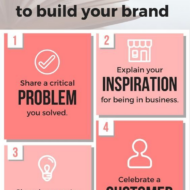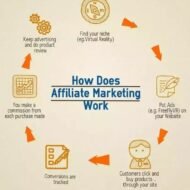Posted by Managementguru in Business Management, Marketing, Sales, Social Media, Strategy
on Mar 14th, 2019 | 0 comments

What Small Businesses Need to Know About Developing a Brand? If I asked you the name of your business, you could probably respond without a second thought. But what if I were to ask you about your brand? What is the story you would tell, the mission you want to achieve, and the unique characteristics that set your business apart from your competitors? You’d probably need a bit more time, but it would be time well spent. Branding is a powerful tool. It can turn first-time customers into loyal followers and long-time customers into word-of-mouth marketers. Branding, when done masterfully, is the reason we apply “Chapstick” to soothe dry lips, eat “Popsicles” to cool down on a hot day, and “Google” the answer to life’s most pressing questions. Needless to say, brand identity is an important component to your business. Picture Courtesy : 4 Compelling Brand Stories You Should Be Telling How Can You Grow Your Brand? Its clear brand development is important, but how do you build it into your marketing efforts? There are numerous answers to that question, but the following often represent the most common and impactful way to increase brand awareness: Content Marketing: In many circles, content is considered the leading way to do everything from improving organic search results to, as you guessed it, increase brand awareness. Through this method, well-curated articles, blog posts, videos, white papers, etc. are used to increase brand credibility. Content is then distributed through various channels, including email, social media, and on the brand’s website or blog. Picture Courtesy: 18 Types of Content Marketing You Can Use To Grow Your Business Ultimately content works to show your brand as a source of knowledge, whether it pertains to industry trends or customer needs. Social Media Advertising: Social media allows business owners to leverage posts, shares, stories, and comments to engage directly with existing and potential customers. While much of that interaction is free, there are additional paid advertising options that can help small business owners take advantage of social media advertising to increase reach. Picture Courtesy: Best Social Media Management Tools – No More Social Media Babysitting Many social media platforms, including LinkedIn, Facebook, Twitter, Instagram, and Snapchat offer paid advertising opportunities that base ad placement on user data. This can place your brand in front of a specific audience base or target user. Charitable Initiatives: Companies like PetSmart, TOMs, and REI have long attracted customers through their dedication to philanthropic initiatives. By doing so, they’ve associated their brands with a specific mission – helping pets, clothing children, or saving the environment. When “giving” initiatives are leveraged correctly, they highlight your brand’s mission and show your commitment to goodwill. As such, your brand gains notoriety among audiences that share similar interests or philanthropic goals. Picture Courtesy: Top 10 Best Free SEO Tools To instantly Improve Your Google Ranking in 2019 Search Engine Marketing (SEM): Today, SEM refers to any type of paid search efforts and has become an umbrella term used to refer to pay-per-click (PPC) and cost-per-click (CPC) marketing strategies. Through this method, you purchase ad space on search engine result pages (SERPS) on Google, Bing, etc. Instead of ranking organically for specific keywords, SEM allows your brand to show up at the top of a SERP, presenting your brand to highly targeted audiences. You Know How to Grow It, But How Do You Pay for It? While each of these methods can help you increase brand awareness, they often come at a price. Social media and SEM ads are often paid promotions that are based on the number of clicks. Content...

Posted by Managementguru in Affiliate Marketing, Marketing
on Apr 13th, 2017 | 0 comments

The Eight Pointer Guide to Choose Affiliate Programs Before joining an affiliate program, do a little research about the choices of program that you intend to join into. Get some answers because they will be the deciding point of what you will be achieving later on. How to Write Killer Content for the Web Will it cost you anything to join? Most affiliate programs being offered today are absolutely free of charge. So why settle for those that charge you some dollars before joining. 1. When do they issue the commission checks? Every program is different. Some issue their checks once a month, every quarter, etc. Select the one that is suited to your payment time choice. Many affiliate programs are setting a minimum earned commission amount that an affiliate must meet or exceed in order for their checks to be issued. Make Money With These 15 Smartphone Apps That Pay You For Using Them 2. What is the hit per sale ratio? This is the average number of hits to a banner or text link it takes to generate a sale based on all affiliate statistics. This factor is extremely important because this will tell you how much traffic you must generate before you can earn a commission from the sale. 3. How are referrals from an affiliate’s site tracked and for how long do they remain in the system? You need to be confident on the program enough to track those people you refer from your site. This is the only way that you can credit for a sale. The period of time that those people stay in the system is also important. This is because some visitors do not buy initially but may want to return later to make the purchase. Know if you will still get credit for the sale if it is done some months from a certain day. HOW TO MAKE FULL TIME INCOME FROM AFFILIATE MARKETING 4. What are the kinds of affiliate stats available? Your choice of affiliate program should be capable of offering detailed stats. They should be available online anytime you decide to check them out. Constantly checking your individual stats is important to know how many impressions, hits and sales are already generated from your site. Impressions are the number of times the banner or text link was viewed by a visitor of your site. A hit is the one clicking on the banner or text links. 5. Does the affiliate program also pay for the hits and impressions besides the commissions on sales? It is important that impressions and hits are also paid, as this will add to the earnings you get from the sales commission. This is especially important if the program you are in offers low sales to be able to hit ratio. 6. Who is the online retailer? Find out whom you are doing business with to know if it is really a solid company. Know the products they are selling and the average amount they are achieving. The more you know about the retailer offering you the affiliate program, the easier it will be for you to know if that program is really for you and your site. How To Work From Home Selling On Amazon FBA 7. Is the affiliate a one tier or two tier program? A single tier program pays you only for the business you yourself have generated. A two tier program pays you for the business, plus it also pays you a commission on the on the sales generated by any affiliate you sponsor in your program. Some two-tier programs are even paying small fees on each...




